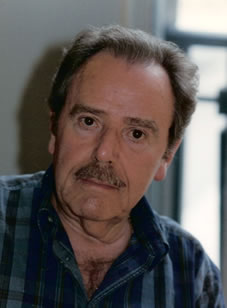Nato nel 1927
a Tour ma parigino d'adozione, Claude Delmouly è stato una delle figure più importanti del bridge francese del quale
ha ininterrottamente dominato la Classifica dal 1970 al 1982.
Ha iniziato a giocatore a bridge ha 11 anni
sotto la guida del padre ma il suo primo vero mentore è stata Irene de
Heredia.
Dal
punto di vista sportivo, Claude ha vinto il primo di una ventina di titoli
nazionali nel 1954 e ha colto le sue maggiori affermazioni vincendo
la prima edizioni delle Olimpiadi
del 1960 e la medaglia d'argento ai
Campionati Europei a Squadre del 1959 a Palermo.
Oltre a innumerevoli Tornei e Campionati Nazionali
vinti ai suoi tempi, Delmouly è stato uno dei Seniores più in auge degli anni '90. In questa
categoria ha vinto: due ori (1997 e 1999), un argento (2001) ed un bronzo
(1995) nei Campionati Europei a Squadre,
un oro e un argento nel Campionato del MEC a Squadre Senior
rispettivamente
nel 1996 e nel 1993, l'argento nella Olimpiade
a Squadre del 2000, il bronzo nella
Senior Bowl del 2001.
Tuttavia, esiste un neo nella carriera del Campione
francese che al ritorno dalle vittoriose Olimpiadi del 1960, fu squalificato per
un anno dalla sua Federazione con l'accusa di farsi il segnale dell'ascensore
con il suo partner di allora Gérard
Bourchtoff.
Claude è anche stato il trainer delle squadre femminili
francesi che hanno vinto l'oro nel
Campionato Europeo a Squadre del 1969 e l'argento in quello del 1981.
Attivo in ogni campo del bridge, nel 1954 ha fondato la
prima scuola di bridge ed ha ideato i primi Tornei a Mani preparate, animatore
di famose crociere bridgistiche, articolista e scrittore, in particolare
ricordiamo il secondo volume de "Le bridge de demain"
scritto con Pierre Ghestem ed un'opera
fondamentale nella storia del bridge francese, quale fu "La
longue naturelle" scritta con Jacques Parienté.
Claude, che era sposato ed aveva una figliastra, si è spento dopo una lunga malattia nel febbraio del
2006.

 Born in 1927
in Tour, but by adoption of Paris, has been one of the most important figures of
the French bridge which has continuously dominated the ranking from 1970 to
1982.
Born in 1927
in Tour, but by adoption of Paris, has been one of the most important figures of
the French bridge which has continuously dominated the ranking from 1970 to
1982.
He began to play bridge has 11 years
under the guidance of his father but his first real mentor was Irene de Heredia.
From a sporting perspective, Claude won
the first of a dozen national titles in 1954 and took his biggest satisfaction
winning the first Olympic Games of 1960 and the silver medal at the 1959
European Team Championships in Palermo.
In addition to numerous tournaments and
won national championships in his young time, was one of the Senior most in
vogue of the '90s. In this category has won two gold medals (1997 and 1999), one
silver (2001) and one bronze (1995) in the European Team Championships, the
silver in the EC Senior Team Championships in 1993 followed by gold in 1996, silver in the 2000 Summer Olympics Team ,
bronze in the Senior Bowl in 2001.
However, there is a nevus in his
career. In the French Championship after the return from the victorious 1960
Olympic Games, was suspended for one year of the Federation and charged with the
signal of the lift with his partner, Gerard Bourchtoff.
Claude was also the trainer of the
French women's teams that won gold in the European Team Championships 1969 and
silver in that of 1981.
Active in every area of the bridge, in
1954 he founded the first school and has designed the first bridge tournaments
with prepared deals, leader of the famous bridge player cruises, columnist and
writer, in particular, please note the second volume of "The bridge de demain"
wrote with Pierre Ghestem and a milestone in the history of the French bridge,
which was "La longue naturelle" written with Jacques Pariente.
Claude, who was married and had a
daughter, died after a long illness in February 2006.

 Animateur de bridge dans des
croisières au Proche-Orient, Claude Delmouly était un précurseur de
cette discipline olympique dont il avait remporté pour la France en
1960 les
premières Olympiades par équipe.
Animateur de bridge dans des
croisières au Proche-Orient, Claude Delmouly était un précurseur de
cette discipline olympique dont il avait remporté pour la France en
1960 les
premières Olympiades par équipe.
Il a été enterré le 8 février 2006, soit juste
quarante-huit heures avant les Jeux olympiques d'hiver de Turin où
avaient eu lieu ces Olympiades.
L'un des plus anciens professionnels du
bridge, Delmouly s'adaptait aux modes de ses élèves qui avaient
quasiment tous fini par se mettre, dès la fin des
années 1970 à la Majeure par 5. Il ne pouvait pratiquer que
très rarement son Contre Delmouly, propre au canapé où le
contre Spoutnik était inopérant puisqu'une ouverture dans
une couleur majeure par 1♠ ou 1♥
n'y indiquait que quatre cartes et non cinq comme en majeure
cinquième.
Après la séquence 1♦
suivi par une intervention adverse à 2♣, ce Contre auquel
il a donné son nom, effectué par le répondant, indique très
précisément zéro, une ou deux cartes dans la couleur
d'ouverture.
Le corollaire, si le répondant passe au
lieu de contrer, est une extension de la convention Lisbonne
inventée par Pierre Ghestem et qui promet alors implicitement
trois cartes ou plus ce qui facilite grandement le réveil
obligatoire de l'ouvreur.
![]() Animateur de bridge dans des
croisières au Proche-Orient, Claude Delmouly était un précurseur de
cette discipline olympique dont il avait remporté pour la France en
1960 les
premières Olympiades par équipe.
Animateur de bridge dans des
croisières au Proche-Orient, Claude Delmouly était un précurseur de
cette discipline olympique dont il avait remporté pour la France en
1960 les
premières Olympiades par équipe. 
